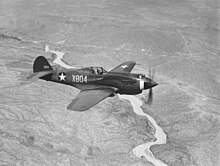| Lt. Colonel Charles DeBow | |
|---|---|
 Charles DeBow Charles DeBow | |
| Birth name | Charles DeBow |
| Born | (1918-02-13)February 13, 1918 Indianapolis, Indiana, US |
| Died | April 4, 1986(1986-04-04) (aged 68) Indianapolis, Indiana, US |
| Buried | Calvary Cemetery, Indianapolis |
| Allegiance | United States of America |
| Service | United States Army Air Force |
| Years of service | 1941–1946 |
| Rank | Lt. Colonel |
| Unit | 332nd Fighter Group |
| Awards | |
| Alma mater | Indiana University Hampton Institute |
| Spouse(s) | Jane Priscilla Stuart |
Charles DeBow (February 13, 1918 – April 4, 1986) was an officer in the U.S. Army Air Force and combat fighter pilot and commanding officer of the 332nd Fighter Group's 301st Fighter Squadron, best known as the prodigious, all-African American Tuskegee Airmen. He was one of the 1,007 documented Tuskegee Airmen Pilots.
In July 1941, DeBow entered aviation cadet training with the Tuskegee Airmen's first class of aviation cadets, Class 42-C-SE. On March 6, 1942, DeBow graduated from aviation cadet training with Captain Benjamin O. Davis Jr., future Tuskegee Airmen Commander and future U.S. four-star general; 2nd Lt. George S. Roberts ("Spanky" Roberts - September 24, 1918 - March 8, 1984), 2nd Lt. Mac Ross (1912-1944), and 2nd Lt. Lemuel R. Custis (1915–2005). Being among the first five to graduate, they "drew the most sustained attention from the press and the black community as a result."
DeBow was the first Indiana native and the first of fourteen individuals with an Indianapolis, Indiana, address of record to graduate from the Tuskegee Advance Flying School (TAFS).
Early life, family
DeBow was born on February 13, 1918, in Indianapolis, Indiana. He was the son of Charles Henry DeBow (September 17, 1891 - March 1981) of Lebanon, Tennessee, and Anna Sue Horne DeBow (December 25, 1896 - January 1980) of Tennessee. DeBow's parents moved from Tennessee to Indianapolis before DeBow was born.
After graduating from Crispus Attucks High School, DeBow enrolled at Indiana University. Though DeBow's father wanted DeBow to study medicine to ensure a good living in a segregated society, DeBow transferred to Hampton Institute to study business and to enroll in the Civil Pilot training course offered there. After working numerous jobs to save money, Debow dropped out of Hampton University to enlist in the U.S. Army.
DeBow was married to Aurelia Jane Priscilla Stuart DeBow (1926–2017). They had several children. DeBow's son, Captain William DeBow, served as the Commander of the Port Hueneme Division, Naval Surface Warfare Center. Daughter Kay DeBow was a co-founder of the National Black Chamber of Commerce (NBCC).
TAFS Roster of Graduates listed DeBow's hometown address as 2043 Boulevard Place, Indianapolis, Indiana.
Military career, Tuskegee Airmen

On July 19, 1941, DeBow was admitted into the U.S. Army Air Corps Tuskegee Aviation Cadet training program's inaugural class at Tuskegee Army Air Field, Class 42-C-SE.
On March 6, 1942, only DeBow and four other cadets graduated from the program: Captain Benjamin O. Davis Jr., 2nd Lt. Lemuel R. Custis, 2nd Lt. Mac Ross, and 2nd Lt. George S. Roberts ("Spanky" Roberts). Class 42-C-SE created America's first African-American U.S. Army Air Corps pilots.
During World War II, DeBow served as squadron commander of the 332rd fighter group's 301st Fighter Squadron. He flew 52 combat missions in World War II's European Theater including aerial coverage for D-Day's Operation Overlord.
During a mission, DeBow was injured and lost his flight status. DeBow left the military with the rank of Lt. Colonel.
Awards
- Congressional Gold Medal awarded to the Tuskegee Airmen in 2006
Post-military career, death
After leaving the military, DeBow returned to the State of Indiana where earned a Master's degree from alma mater Indiana University and another Master’s degree from Butler University. DeBow became an English teacher at Indianapolis, Indiana's Thomas Carr Howe High School where he remained for 10 years. He later became an associate English lecturer at IUPUI until his death on April 4, 1986.
See also
- Executive Order 9981
- List of Tuskegee Airmen
- List of Tuskegee Airmen Cadet Pilot Graduation Classes
- Military history of African Americans
References
- ^ Caf Rise Above. "Charles Henry DeBow, Jr."
- "Tuskegee Airmen Pilot Roster". CAF Rise Above. Retrieved 11 August 2020.
- ^ Indiana University-Bloomington Libraries. "Charles DeBow: an Original Tuskegee Pilot". Indiana University Archives. November 7, 2016.
- Kai Wright (2002). Soldiers of Freedom: An Illustrated History of African Americans in the Armed Forces. Black Dog & Leventhal. p. 174. ISBN 9781579122539.
Lieutenants Lemuel Custis, Charles DeBow, George Roberts, and Mac Ross were the first four to graduate, in March of 1942, and drew the most sustained attention from the press and the black community as a result.
- ^ Indianapolis Chapter, Tuskegee Airmen Inc.
- ^ Edwards-Moore Family Genealogy. "Charles Henry DeBow".
- National Black Chamber of Commerce. "NBCC CoFounder Honors Veterans and Remembers Her Father as one of the original Tuskegee Airmen pilots in Alabama".
- Rice, Markus. "The Men and Their Airplanes: The Fighters." Tuskegee Airmen, 1 March 2000.
- "Air Force Historical Support Division > Home" (PDF). Retrieved February 7, 2017
- "TUSKEGEE AIRMEN CHRONOLOGY". DANIEL L. HAULMAN. ORGANIZATIONAL HISTORY BRANCH. AIR FORCE HISTORICAL RESEARCH AGENCY. MAXWELL AFB, AL 36112-6424. November 14, 2011.
- "S.Con.Res.15 - A concurrent resolution authorizing the Rotunda of the Capitol to be used on March 29, 2007, for a ceremony to award the Congressional Gold Medal to the Tuskegee Airmen". Congress.gov. US Library of Congress. 6 March 2007. Retrieved 22 September 2021.
Notes
- The Tuskegee Airmen trained with the P-40 aircraft. Later the Tuskegee Airmen became known for flying the P-51 aircraft with red markings that distinguished the Tuskegee Airmen included red bands on the noses of P-51s as well as a red rudder; their P-51B and D Mustangs flew with similar color schemes, with red propeller spinners, yellow wing bands and all-red tail surfaces.
